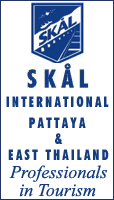The Eastern Seaboard Industrial Estate has
a sign proclaiming it to be "The Detroit of the
East". With GM and Ford/Mazda on board, plus a host of
parts suppliers, they are probably quite justified. Thailand
is the auto hub of ASEAN is the proud boast. But while basking
in that pride, let us not forget the Thai automakers, some of
whom you may never have heard of, like Od Srikuangow who is
the boss of Skylab.
The SkyLab factory is based in Koh Si
Chang, that small island 40 minutes by ferry boat from the
Eastern Seaboard’s Sriracha port. It is also an island that
boasts around 100 of the SkyLab style of vehicles, though
SkyLab is the major producer of the latest technology
vehicles.

Od
Srikuangow
I have to admit that I have always been a
great admirer of practical engineering, and the SkyLab
embodies all of that. It is a vehicle that has evolved. With
the SkyLab engineering and technology being driven by many
factors, including the local topography, it is a very good
example of how Thailand seized upon concept of the internal
combustion engine, very early in its history, as opposed the
neighbouring countries. That concept in turn has been
producing people like Od Srikuangow, a very practical
engineer.
The Bangkok tuk-tuk was a utilitarian three
wheeled vehicle for the nation’s capital till a few years
ago, and then they began to filter out into the provinces. You
don’t have to look far to see (and hear) many of them
buzzing around the streets. The 400 cc Daihatsu twin cylinder
engine delivering enough power to ferry three people and
groceries, with its exhaust note giving it the eponymous name
of tuk-tuk. Of course, eventually someone ‘exported’ one
to Koh Si Chang about 10 years ago, and that is where the
SkyLab saga began.
Koh Si Chang is not flat, being an old
volcanic plug, and the small engined 3 wheeled tuk-tuk was no
match for the gradients - something larger was needed. The
ubiquitous Corolla engine of 1200 cc delivered power that was
more than adequate, but the normal 3 wheeler gearbox was not
up to the new grunt, so why not use the Toyota gearbox too?
Unfortunately this new power train did not fit within the
confines of the chassis and it was obvious a major re-think
was required.

Skylabs
lined up on the wharf.
The end result was the archetypal Koh Si
Chang 3 wheeler ("samlor"). This was longer and
wider than the tuk-tuks, yet retained the motorcycle style
front forks and handlebars, but incorporated a car engine and
gearbox and differential. Brakes and clutch were foot
actuated, while the accelerator was still a hand throttle
mounted on the handle bars.
Using the old adage of ‘Form follows
Function’ the design of the handlebars becomes apparent. Koh
Si Chang has very tight and tortuous roads with sharp bends.
With a flat bar, the rider would not have long enough arms to
hang on to the grips while turning 300 degree corners, but
with the ‘ape hanger’ style, the grips are kept closer to
the rider/driver.
So now we come to SkyLab. Od’s factory
adjoins his house, and like many SME’s (very small!) in
Thailand, the footpath is looked upon as an extension of the
workshop space. Being a major producer of the local vehicular
transport obviously helps acceptance of this. The main
manufacturing equipment includes a compressor and an electric
welder, kept inside, while the manual pipe bender lives
outside in the elements.
The SkyLab design is a simple ladder frame
built from 2 inch seamless thick-walled tube, with 1 inch
elsewhere. The ladder arms are brought together at the front
and angled up to become the headstock for the motorcycle
forks, which are kept at a more vertical angle to allow for
the extremely sharp turns. At the rear, the "cabin"
is supported on 1 inch angle, built in box formation up from
the tubular ladder arms.
The engine is mounted using standard rubber
mounts and the gearbox is supported from beneath by a
cross-member. The auto derived live axle is suspended on two
leaf springs using U-bolts in standard pattern and the normal
hydraulic brakes are retained.
Since the wheel does not need to be
reinvented, a standard motorcycle petrol tank is employed,
though the affixed decals proclaiming Honda, Yamaha or
Kawasaki do not mean that the front forks came from the same
source. Owners often replace these decals with others of
equally less significance, such as "BMW", another
locally represented manufacturer which has absolutely no part
in a SkyLab!
The basic design is such that it can easily
be converted and there are pick-up versions and a new "Songtaew"
(seats facing each other) as well as the standard forward and
rearward facing seats model, just like the major manufacturers’
common platform technology allows several body styles to be
built upon it. The top of the line model retails between
90-100,000 baht, depending on the level of extras.
Toyota are talking 30,000 cars a year for
the new Soluna Vios, but Od’s production is only around five
SkyLabs a year, with the detailed bodywork taking most of that
time as the basic frame is welded together in three days.
Being an island, salt water corrosion is a problem and the
deluxe SkyLabs have stainless steel bodies, again making
production times longer.
While it is easy to look at the work done
by a basic ‘backyard’ manufacturer and smile, it should be
remembered that Henry Ford I, Karl Benz and even Henry Durant
all initially manufactured vehicles by using practical
engineering to overcome the problems of the day. They too
produced vehicles that were primitive, but they did what was
asked of the vehicles - ferried people and goods around the
countryside. The world needs the Od Srikuangows, even today.
People who can conceptualise an idea and then convert it to
reality. For me, Od’s ‘factory’ was as exciting as any
other assembly line, but even more so, as you could see first
hand the workings of the human mind as it fashions a device to
be used for a specific purpose. If ferrying people and goods
around Koh Si Chang is your needs, the vehicle you need is a
SkyLab!











